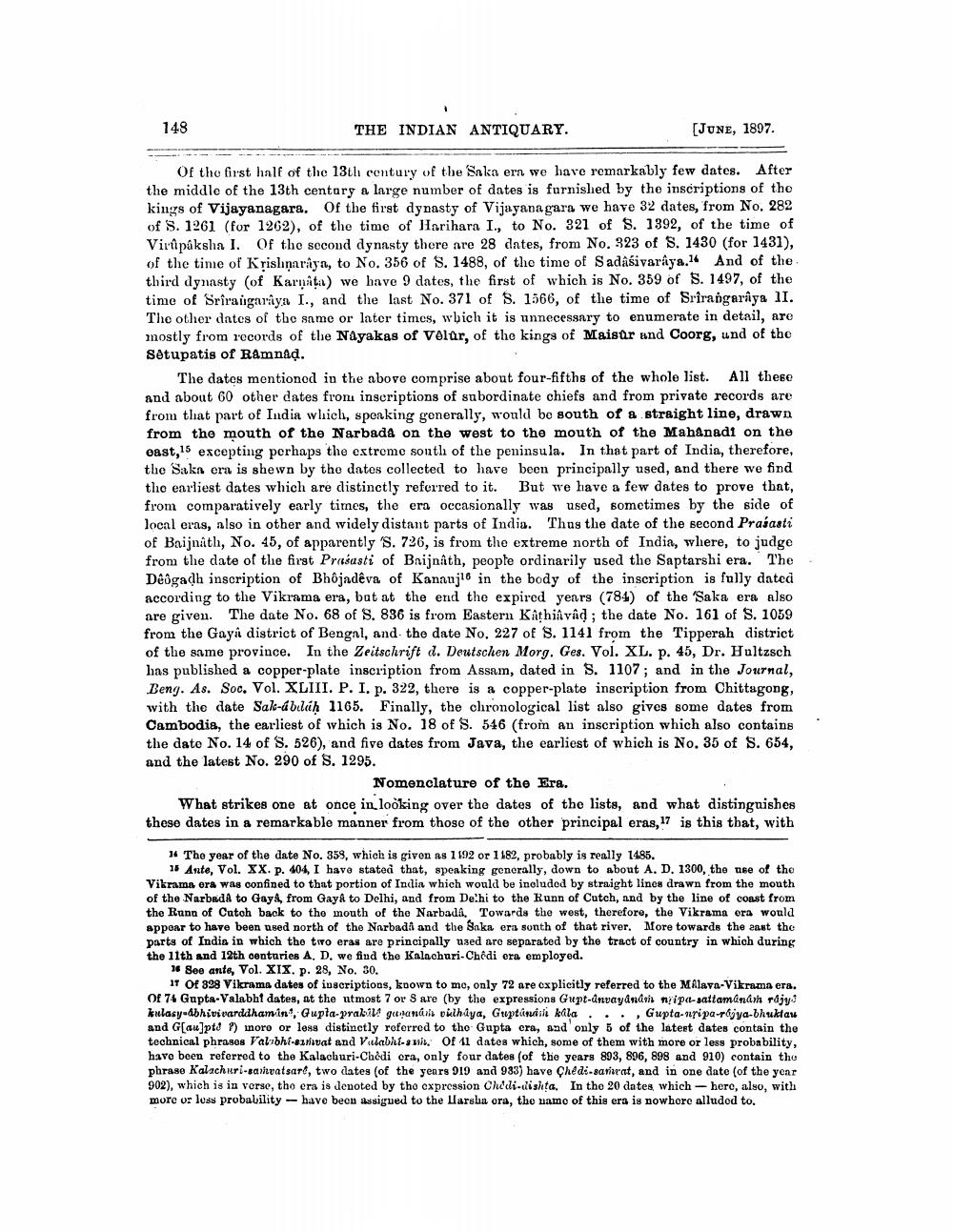________________
148
THE INDIAN ANTIQUARY.
[JUNE, 1897.
Of the first half of the 13th century of the Snka ern we have remarkably few dates. After the middle of the 13th century a large number of dates is furnished by the inscriptions of the kings of Vijayanagara. Of the first dynasty of Vijayanagara we have 32 dates, from No. 282 of S. 1261 (for 1262), of the time of Harihara I., to No. 321 of S. 1392, of the time of Virupaksha I. Of the second dynasty there are 28 dates, from No. 323 of S. 1430 (for 1431), of the time of Krislinaraya, to No. 356 of S. 1488, of the time of Sadasivaraya. And of the third dynasty (of Karnata) we have 9 dates, the first of which is No. 359 of S. 1497, of the time of Srirangaraya I., and the last No. 371 of S. 1566, of the time of Srirangarîya lI. The other dates of the same or later times, wbich it is unnecessary to enumerate in detail, are mostly from records of the Nayakas of Volur, of the kings of Maisar and Coorg, und of the Setupatis of Ramnad.
The dates mentioned in the above comprise about four-fifths of the whole list. All these and about 60 other dates from inscriptions of subordinate chiefs and from private records are from that part of India which, speaking generally, would be south of a straight line, drawn from the mouth of the Narbada on the west to the mouth of the Mahanadi on the east,15 excepting perhaps the extreme south of the peninsula. In that part of India, therefore, the Saka era is shewn by the dates collected to have been principally used, and there we find the earliest dates which are distinctly referred to it. But we have a few dates to prove that, from comparatively early times, the era occasionally was used, sometimes by the side of local eras, also in other and widely distant parts of India. Thus the date of the second Prasasti of Baijnath, No. 45, of apparently 'S. 726, is from the extreme north of India, wliere, to judge from the date of the first Prasasti of Brijnath, people ordinarily used the Saptarshi era. The Deogadh inscription of Bhôjadêva of Kanaujl in the body of the inscription is fully dated according to the Vikrama era, but at the end the expired years (784) of the 'Saka era also are given. The date No. 68 of S. 836 is from Eastern Kathiivad ; the date No. 161 of S. 1059 from the Gayá district of Bengal, and the date No. 227 of S. 1141 from the Tipperah district of the same province. In the Zeitschrift d. Deutschen Morg. Ges. Vol. XL. p. 45, Dr. Hultzsch has published a copper-plate inscription from Assam, dated in S. 1107; and in the Journal, Beng. As. Soc. Vol. XLIII. P. I. p. 322, there is a copper-plate inscription from Chittagong, with the date Sal-abilah 1165. Finally, the chronological list also gives some dates from Cambodia, the earliest of which is No. 18 of S. 546 (from an inscription which also contains the date No. 14 of S. 526), and five dates from Java, the earliest of which is No. 35 of S. 654, and the latest No. 290 of S. 1295.
Nomenclature of the Era. What strikes one at once in looking over the dates of the lists, and what distinguishes these dates in a remarkable manner from those of the other principal eras, 7 is this that, with
1 The year of the date No. 359, which is given as 1192 or 1182, probably is really 1485.
15 Ante, Vol. XX. p. 404, I have stated that, speaking generally, down to about A. D. 1300, the use of the Vikrama era was confined to that portion of India which would be included by straight lines drawn from the mouth of the Narbadd to Gay&, from Gaya to Delhi, and from Delhi to the Runn of Cutch, and by the line of coast from the Run of Catch back to the mouth of the Narbadá. Towards the west, therefore, the Vikrama era would appear to have been used north of the Norbada and the Baka era sonth of that river. More towards the east the parts of India in which the two eras are principally used are separated by the tract of country in which during the 11th and 12th centuries A. D. we find the Kalachuri-Chedi era employed.
* See ante, Vol. XIX. p. 28, No. 30.
17 Of 828 Vikrama dates of inscriptions, koown to mo, only 72 are explicitly referred to the MÁlava-Vikrama era. Of 74 Gupta-Valabht dates, at the utmost 7 or S are (by the expressions Gupt-unvayanani nipa-sattamanan räjy kulasy-abhivivarddhamin, Gupta-prabili garanárh puthiya, Guptusaili kala..., Gupta-uripa-rajya-bhuktau and G[au]pt# i) moro or less distinctly referred to the Gupta cra, and only 5 of the latest dates contain the technical phrases Valbhf-
e vat and Vilabhi-suht. Of 41 dates which, some of them with more or less probability, have been referred to the Kalachuri-Chedi cra, only four dates of the years 893, 896, 898 and 910) contain the phrase Kalachuri-barizvatsard, two clates (of the years 919 and 933) have Çhedi-sariwat, and in one date (of the year 902), which is in vorse, tho era is denoted by tho expression Chudi-dishta. In tho 20 dates, which here, also, with more or loss probability have been assigned to the Harsha ora, the name of this era is nowhere alludod to.




